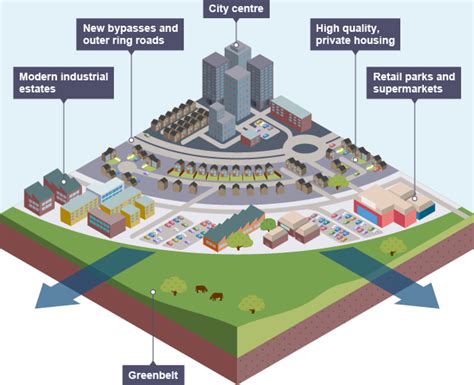Introduction:

Urban sprawl, characterized by the unchecked expansion of urban areas into previously rural or undeveloped regions, has become a prevalent phenomenon in modern society. Its widespread effects have ignited significant concern among urban planners, policymakers, and concerned citizens alike. This article delves into the complex dynamics of urban sprawl, its causes, consequences, and potential solutions, drawing upon insights from AP Human Geography.
Causes of Urban Sprawl:
- Economic Growth and Job Creation: The concentration of economic activity in urban centers attracts workers, leading to increased demand for housing and infrastructure, fueling suburban expansion.
- Transportation Advancements: The proliferation of private automobiles and improved transportation infrastructure enables individuals to live farther from urban cores, contributing to sprawl.
- Land Availability: The availability of relatively inexpensive land on the outskirts of urban areas entices developers to build new subdivisions and commercial establishments.
- Urban Renewal and Gentrification: The rehabilitation and redevelopment of older urban areas increase property values, leading to the displacement of low-income residents who move to cheaper outlying areas.
Consequences of Urban Sprawl:
- Environmental Degradation: The conversion of natural habitats and agricultural land into urban developments reduces biodiversity, increases pollution, and exacerbates climate change.
- Infrastructure Strain: Sprawling cities require extensive roads, utilities, and public services, placing a significant burden on infrastructure systems and increasing maintenance costs.
- Social Disparities: Suburban development often caters to affluent residents, while low-income populations struggle to afford housing and access essential services in more central locations.
- Transportation Challenges: Commuting distances increase with urban sprawl, leading to traffic congestion, air pollution, and reduced quality of life.
- Health Concerns: The sedentary lifestyle associated with suburban living, coupled with increased exposure to air pollution, can lead to obesity, respiratory problems, and other health issues.
Strategies for Mitigating Urban Sprawl:
- Smart Growth: This approach promotes dense, mixed-use development within existing urban areas, reducing the need for suburban expansion.
- Urban Renewal and Revitalization: Investing in the rehabilitation and improvement of older urban neighborhoods creates attractive and affordable housing options closer to city centers.
- Transportation Planning: Prioritizing public transportation, biking, and walking over private vehicle use reduces the reliance on sprawling development.
- Land Use Planning and Zoning: Regulating land use and zoning laws to limit the encroachment of urban development into rural areas can protect environmentally sensitive and agricultural lands.
Data and Statistics on Urban Sprawl:
| Characteristic | Statistics |
|---|---|
| Global Urban Population (2020) | 56.2% |
| Projected Global Urban Population (2050) | 68.4% |
| Land Consumption by Urban Sprawl (US) | 100 acres per day |
| Commuting Distance (US) | 16.6 miles on average |
| Greenhouse Gas Emissions from Urban Sprawl (US) | 66% |
Tips and Tricks for Addressing Urban Sprawl:
- Encourage Mixed-Use Development: Promote the construction of buildings that combine residential, commercial, and recreational uses to reduce urban sprawl.
- Invest in Public Transportation: Expand and improve public transportation systems to provide convenient and affordable alternatives to private vehicles.
- Support Smart Land Use Planning: Implement zoning regulations that delineate clear boundaries between urban and rural areas.
- Revitalize Urban Cores: Invest in the rehabilitation and improvement of older urban areas to create attractive and livable neighborhoods.
Pros and Cons of Urban Sprawl:
Pros:
- Economic Growth: Urban sprawl can foster economic development by attracting businesses and creating jobs.
- Affordable Housing: Suburban areas often provide more affordable housing options for families and individuals.
- Quality of Life: Some suburban residents may enjoy a higher quality of life due to access to open spaces, recreational facilities, and lower crime rates.
Cons:
- Environmental Degradation: Urban sprawl destroys natural habitats and increases pollution.
- Infrastructure Strain: Sprawling cities require extensive and costly infrastructure systems.
- Social Disparities: Urban sprawl can contribute to social inequality by separating affluent residents from low-income populations.
- Health Concerns: Suburban living can promote sedentary lifestyles and expose residents to air pollution.
Frequently Asked Questions:
-
What is the difference between urban sprawl and suburbanization?
– Urban sprawl is the unchecked expansion of urban areas, while suburbanization refers to the population shift from urban to suburban areas. -
What are the main causes of urban sprawl?
– Economic growth, transportation advancements, land availability, and urban renewal are key drivers of urban sprawl. -
What are the negative consequences of urban sprawl?
– Environmental degradation, infrastructure strain, social disparities, transportation challenges, and health concerns are common consequences of urban sprawl. -
What can we do to reduce urban sprawl?
– Implementing smart growth strategies, revitalizing urban cores, prioritizing public transportation, and regulating land use planning can help mitigate urban sprawl. -
What are the advantages of smart growth?
– Smart growth reduces urban sprawl, preserves natural habitats, improves urban livability, and promotes economic development. -
How does urban sprawl contribute to social inequality?
– Urban sprawl can create barriers between affluent and low-income populations, leading to disparities in housing, education, and access to essential services.
Conclusion:
Urban sprawl remains a complex and multifaceted challenge facing modern society. By understanding its causes, consequences, and potential solutions, we can develop informed policies and strategies to mitigate its detrimental effects and foster sustainable urban growth. Through collaboration between urban planners, policymakers, and citizens, we can create more livable, equitable, and environmentally conscious cities for future generations.
